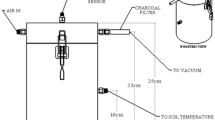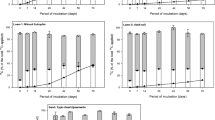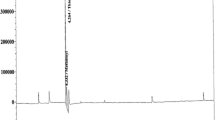Abstract
Methyl isothiocyanate (MITC, CH3NCS) is the primary breakdown product of metam-sodium, and a potential replacement fumigant pesticide for methyl bromide. Methyl isothiocyanate is toxic and has a high potential for volatilization, therefore, minimizing its atmospheric emission is of the utmost importance. One method to reduce fumigant emissions is to enhance their degradation by incorporating organic amendments into the soil surface. In this study we determined the combined effect of temperature and chicken manure application rate on the degradation of MITC. The degradation of MITC was significantly accelerated by both increasing temperature and amendment rate. Differences between sterile and nonsterile degradation kinetics in unamended and organically amended soil indicate that MITC degradation is equally controlled by chemical and biological processes. The amelioration of soil with organic amendments should be further considered when designing fumigation practices that allow for reduced emissions.
Similar content being viewed by others
References
Abdel Magid, H. M., Sabrah, R. E. A., Rabi, R. K., El Nadi, A. R. H. and Abdel Aal, S. I.: 1993, ‘Biodegradation of municipal refuse and chicken manure in a winter-wheat ecosystem in Saudi Arabia’, J. Arid Environ. 25, 411–419.
Anonymous: 1990, ‘Summary of toxicity data on methyl isothiocyanate (MITC)’, J. Pesticide Sci. 15, 297–304.
Baker, L. W., Fitzell, D. L., Seiber, J. N., Parker, T. R., Shibamoto, T., Poor, M. W., Longley, K. E., Tomlin, R. P., Propper, R. and Duncan, D. W.: 1996, ‘Ambient air concentrations of pesticides in California’, Environ. Sci. Technol. 30, 1365–1368.
Boesten, J. J. T. I., Van der Pas, L. J. T., Smelt, J. H. and Leistra, M.: 1991, ‘Transformation rate of methyl isothiocyanate and 1,3-dichloropropene in water-saturated sandy subsoils’, Neth. J. Agric. Sci. 39, 179–190.
Dagley, S.: 1984, ‘Introduction’ in D. T. Gibson (ed.), Microbial Degradation of Organic Compounds, Marcel Dekker, NY, U.S.A., pp. 1–11.
Gan, J., Yates, S. R., Papiernik, S. and Crowley, D.: 1998a, ‘Application of organic amendments to reduce volatile pesticide emissions from soil’, Environ. Sci. Technol. 32, 3094–3098.
Gan, J., Yates, S. R., Crowley, D. and Becker, J. O.: 1998b, ‘Acceleration of 1,3-dichloropropene degradation by organic amendments and potential application for emissions reduction’, J. Environ. Qual. 27, 408–414.
Gan, J., Papiernik, S. K., Yates, S. R. and Jury, W. A. 1999, ‘Temperature and moisture effects on fumigant degradation in soil’, J. Environ. Qual. 28, 1436–1441.
Garciá-Valcárcel, A. I. and Tadeo, J. L.: 1999, ‘Influence of soil moisture on sorption and degradation of hexazinone and simazine in soil’, J. Agric. Food Chem. 47, 3895–3900.
Gerstle, Z., Mingelgrin, U. and Yaron, B.: 1977, ‘Behavior of vapam and methylisothiocyanate in soils’, Soil Sci. Soc. Am. J. 41, 545–548.
Horvath, R. S.: 1972, ‘Microbial cometabolism and the degradation of organic compounds in nature’, Bacteriol. Rev. 36, 146–155.
Kassie, F., Laky, B., Nobis, E., Kundi, M. and Knasmüller, S.: 2001, ‘Genotoxic effects of methyl isothiocyanate’, Mutation Res. 490, 1–9.
Ogram, A. V., Jessup, R. E., Ou, L. T. and Rao, P. S. C.: 1985, ‘Effects of sorption on biological degradation rates of 2,4-dichlorophenoxyaceitic acid in soils’, Appl. Environ. Microbiol. 49, 582–587.
O'Hallorans, J. M., Muñoz, M. A. and Colberg, O.: 1993, ‘Effect of chicken manure on chemical properties of a mollisol and tomato production’, J. Agric. Univ. Puerto Rico 77, 181–191.
O'Hallorans, J. M., Muñoz, M. A. and Marquez, P. E.: 1997, ‘Chicken manure as an amendment to correct soil acidity and fertility’, J. Agric. Univ. Puerto Rico 81, 1-8, 900.
Ottnad, M., Jenny, N. A. and Röder, C.-H.: 1978, ‘Methyl Isothiocyanate’, Analytical Methods for Pesticides, Plant Growth Regulators, and Food Additives, Vol. 10, Academic Press, NY, U.S.A., pp. 563–573.
Shelton, D. R. and Parkin, B.: 1991, ‘Effect of moisture on sorption and biodegradation of carbofuran in soil’, J. Agric. Food Chem. 39, 2063–2068.
Smelt, J. H. and Leistra, M.: 1974, ‘Conversion of metham-sodium to methyl isothiocyanate and basic data on the behavior of methyl isothiocyanate in soil’, Pestic. Sci. 5, 401–407.
Smelt, J. H., Crum, S. J. H. and Teunissen, W.: 1989, ‘Accelerated transformations of the fumigant methyl isothiocyanate in soil after repeated application of metam-sodium’, Environ. Sci. Health B 24, 437–455.
Speitel, G. E., Lu, C. J., Turakhia, M. and Sho, X.-J.: 1988, ‘Biodegradation of trace concentrations of substituted phenols in granular activated carbon columns’, Environ. Sci. Technol. 22, 68–74.
Taylor Jr., G. E., Schaller, K. B., Geddes, J. D., Gustin, M. S., Lorson, G. B. and Miller, G. C.: 1996, ‘Microbial ecology, toxicology and chemical fate of methyl isothiocyanate in riparian soils from the upper Sacramento river’, Environ. Tox. Chem. 13, 1694–1701.
Trout, T.: 2001, ‘California Regulatory Impacts on Adoption of Methyl Bromide Alternative Fumigants’, Methyl Bromide Alternatives, Vol. 7(3), USDA, Washington, D.C., pp. 4–7.
Van den Berg, F.: 1992, ‘Measured and computed concentrations of methyl isothiocyanate in the air around fumigated fields’, Atmos. Environ. 27A, 63–71.
Van den Berg, F., Smelt, J. H., Boesten, J. J. T. I. and Teunissen, W.: 1999, ‘Volatilization of methyl isothiocyanate from soil after application of metam-sodium with two techniques’, J. Environ. Qual. 28, 918–928.
Walker, A., Moon, Y.-H. and Welch, S. J.: 1992, ‘Influence of temperature, soil moisture and soil characteristics on the persistence of alachlor’, Pestic. Sci. 35, 109–116.
Author information
Authors and Affiliations
Corresponding author
Rights and permissions
About this article
Cite this article
Dungan, R.S., Gan, J. & Yates, S.R. Accelerated Degradation of Methyl Isothiocyanate in Soil. Water, Air, & Soil Pollution 142, 299–310 (2003). https://doi.org/10.1023/A:1022092907878
Issue Date:
DOI: https://doi.org/10.1023/A:1022092907878




